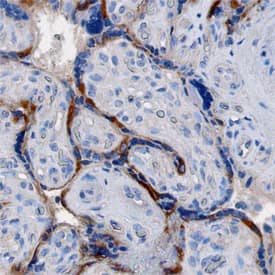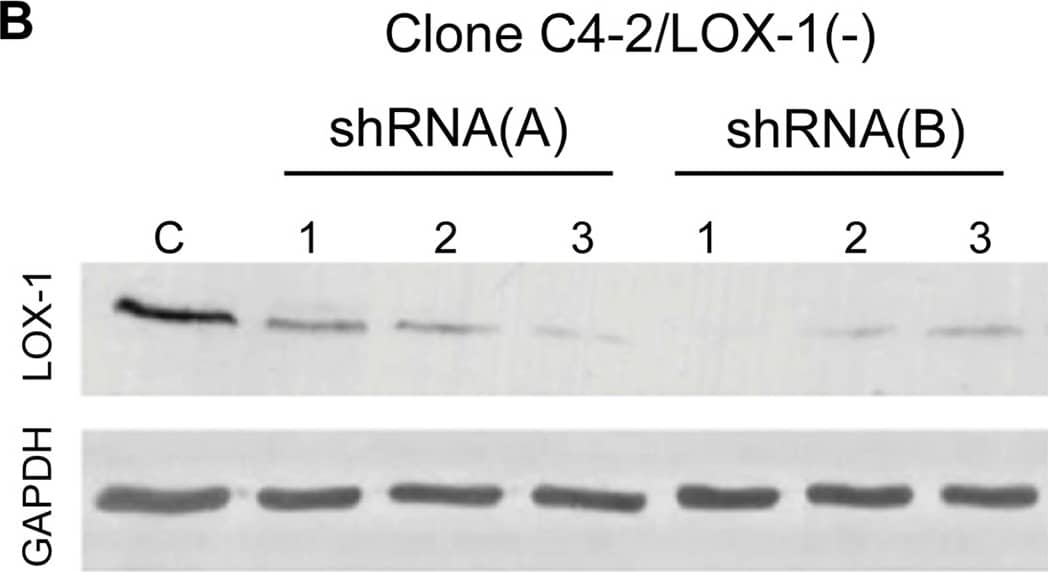Human LOX-1/OLR1 Antibody
R&D Systems, part of Bio-Techne | Catalog # AF1798


Key Product Details
Validated by
Species Reactivity
Validated:
Cited:
Applications
Validated:
Cited:
Label
Antibody Source
Product Specifications
Immunogen
Ser61-Gln273
Accession # P78380
Specificity
Clonality
Host
Isotype
Endotoxin Level
Scientific Data Images for Human LOX-1/OLR1 Antibody
LOX‑1/OLR1 in Human Placenta.
LOX-1/OLR1 was detected in immersion fixed paraffin-embedded sections of human placenta using Goat Anti-Human LOX-1/OLR1 Antigen Affinity-purified Polyclonal Antibody (Catalog # AF1798) at 1 µg/mL overnight at 4 °C. Tissue was stained using the Anti-Goat HRP-DAB Cell & Tissue Staining Kit (brown; Catalog # CTS008) and counterstained with hematoxylin (blue). Specific staining was localized to cytotrophoblasts. View our protocol for Chromogenic IHC Staining of Paraffin-embedded Tissue Sections.Detection of Human LOX-1/OLR1 by Immunocytochemistry/Immunofluorescence
Generation of stable prostate cancer cell lines with LOX-1 over-expression and shRNA against olr1.A) Western blot for LOX-1 (40 kDa) expression in human CaP clones with overexpression of LOX-1. B) Western blot for LOX-1 (40 kDa) expression in human prostate cancer cell clones with LOX-1 knockdown C) Real-time PCR for LOX-1 expression in three clones with overexpression of LOX-1. D) Real-time PCR for LOX-1 expression was determined in three clones that express shRNA/LOX-1(A), and three clones that express shRNA/LOX-1(B). The data represent the means ± S.D. of three independent experiments performed in triplicate, and statistically analyzed using one-way analysis of variance and Dunnett’s post-test; (***p≤0.001, **p≤0.01, *p≤0.05). Image collected and cropped by CiteAb from the following publication (https://pubmed.ncbi.nlm.nih.gov/25170920), licensed under a CC-BY license. Not internally tested by R&D Systems.Detection of Human LOX-1/OLR1 by Western Blot
Generation of stable prostate cancer cell lines with LOX-1 over-expression and shRNA against olr1.A) Western blot for LOX-1 (40 kDa) expression in human CaP clones with overexpression of LOX-1. B) Western blot for LOX-1 (40 kDa) expression in human prostate cancer cell clones with LOX-1 knockdown C) Real-time PCR for LOX-1 expression in three clones with overexpression of LOX-1. D) Real-time PCR for LOX-1 expression was determined in three clones that express shRNA/LOX-1(A), and three clones that express shRNA/LOX-1(B). The data represent the means ± S.D. of three independent experiments performed in triplicate, and statistically analyzed using one-way analysis of variance and Dunnett’s post-test; (***p≤0.001, **p≤0.01, *p≤0.05). Image collected and cropped by CiteAb from the following publication (https://pubmed.ncbi.nlm.nih.gov/25170920), licensed under a CC-BY license. Not internally tested by R&D Systems.Applications for Human LOX-1/OLR1 Antibody
Blockade of Receptor-ligand Interaction
Immunohistochemistry
Sample: Immersion fixed paraffin-embedded sections of human placenta
Western Blot
Sample: Recombinant Human LOX-1/OLR1 (Catalog # 1798-LX)
Reviewed Applications
Read 3 reviews rated 4 using AF1798 in the following applications:
Formulation, Preparation, and Storage
Purification
Reconstitution
Formulation
Shipping
Stability & Storage
- 12 months from date of receipt, -20 to -70 °C as supplied.
- 1 month, 2 to 8 °C under sterile conditions after reconstitution.
- 6 months, -20 to -70 °C under sterile conditions after reconstitution.
Background: LOX-1/OLR1
Lectin-like oxidized low-density-lipoprotein receptor-1 (LOX-1), also known as oxidized low-density-lipoprotein receptor-1 (OLR-1), is a type II transmembrane receptor belonging to the C-type lectin family (1). It also belongs to the functionally defined scavenger receptor (SR) superfamily, whose members share the common ability to bind and internalize modified forms of Low Density Lipoproteins (LDL) (2 - 4). LOX-1 is the first member of the class E scavenger receptor subfamily (SR-E). It binds and supports the internalization of multiple structurally unrelated macromolecules including oxidized LDL, advanced glycation end products (AGE), activated platelets, bacteria, apoptotic or aged cells, and heat shock proteins (5 - 7). LOX-1 has also been implicated as an intestinal receptor involved in the transcytosis of pancreatic bile salt-dependent lipase (8). The human LOX-1 gene encodes a 273 amino acid (aa) residue protein with a short N-terminal intracellular domain, a transmembrane domain, an extracellular stalk/neck region followed by a C-type lectin-like domain (CTLD) (1, 6). The CTLD, which is required for ligand recognition, contains the six conserved cysteine residues present in all C-type lectins, but lacks the Ca2+-binding residues found in classical C-type lectins. LOX-1 can be detected on activated endothelial cells, vascular smooth muscle cells, macrophages, intestinal cells and dendritic cells (6 - 8). The expression of LOX-1 is induced by proinflammatory or proatherogenic stimuli, as well as by oxidized LDL itself and hemodynamic or oxidative stress. Human LOX-1 exists on the cell surface as covalent homodimers, which can further associate into non-covalent-linked oligomers (9). Cell surface LOX-1 can also be cleaved by yet unidentified proteases to release the soluble LOX-1 extracellular domain (6). Binding and endocytosis of oxidized LDL by LOX-1 induces oxidative stress, activates NF kappaB, and upregulates the expression of monocyte chemoattractant protein-1 and matrix metalloproteases (5 - 9). LOX-1-dependent oxidized LDL uptake also induces apoptosis by inducing the expression of the pro-apoptotic Bax and downregulation of the anti-apoptotic Bcl-2 (10). Oxidized LDL plays a key role in the pathogenesis of atherosclerosis and endothelial dysfunction. Blockade of LOX-1 functions may turn out to be a suitable target for the therapeutic intervention of atherosclerosis.
References
- Sawamura, T. et al. (1997) Nature 386:73.
- Daugherty, A. et al. (2000) Curr. Opin. Cardiovasc. Pulm. Ren. Invest. Drugs. 2:223.
- Platt, N. and S. Gordon (2001) J. Clin. Invest. 108:649.
- Platt, N. and S. Gordon (1998) Chem. Biol. 5:R193.
- Jono, T. et al. (2002) FEBS Lett. 511:170.
- Kume, N. et al. (2001) Curr. Opin. Lipidol. 12:419.
- Delneste, Y. et al. (2002) Immunity 17:353.
- Bruneau, N. et al. (2003) Mol. Biol. Cell 14:2861.
- Xie, Q. et al. (2004) DNA and Cell Biol. 23:111.
- Chen, J. et al. (2003) Circ. Res. 94:370.
Long Name
Alternate Names
Gene Symbol
UniProt
Additional LOX-1/OLR1 Products
Product Documents for Human LOX-1/OLR1 Antibody
Product Specific Notices for Human LOX-1/OLR1 Antibody
For research use only



